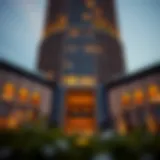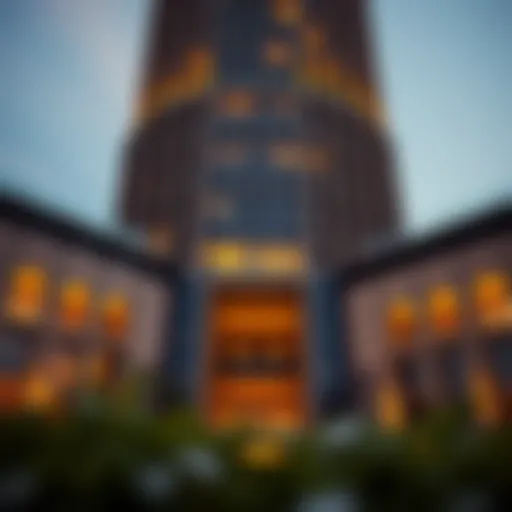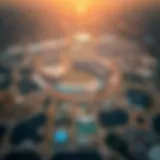Exploring Al Falaj Market: History, Culture, and Impact
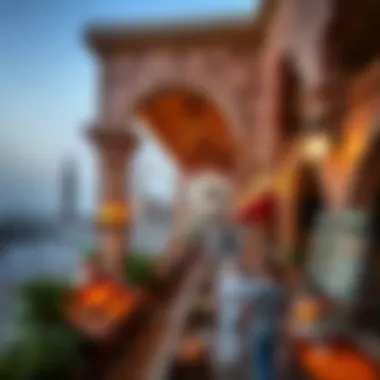

Intro
Welcome to the fascinating world of Al Falaj Market, a significant site within Dubai's property landscape. This article will delve into the essence of this market, shedding light on its history, cultural importance, and economic ramifications. Al Falaj Market is not merely a place for transactions; it serves as a microcosm of Dubai's rich heritage and its dizzying pace of development. For investors, realtors, homebuyers, developers, and analysts alike, gaining insight into Al Falaj represents an invaluable opportunity.
In the sections that follow, we will explore important themes and trends in this market. From understanding current market analysis to spotting historical trends that shape future predictions, you'll discover an enriching depth to this locale. Furthermore, we will take an inventory of property listings and the contrasting nature of luxury and affordable housing options available.
These elements combine to equip you with the knowledge needed to navigate through Al Falaj Market effectively, whether you are making a purchase, a sale, or simply looking to enhance your understanding of Dubai’s real estate potential. Let’s embark on this exploration to arm ourselves with insights that matter.
Market Trends and Insights
Current Market Analysis
The Al Falaj Market is currently thriving, characterized by a robust blend of historical charm and modern convenience. As Dubai continues to attract both national and international investors, property values here have seen a steady escalation. The interest in this area is palpable, with its strategic location serving as a catalyst for real estate growth. High demand has resulted in a low inventory for residences, driving prices up.
According to recent data, the rental yields in Al Falaj are notably attractive compared to other areas in the city. Prospective investors must recognize how these dynamics influence their decision-making process and the potential return on investment they can expect.
Historical Trends and Future Predictions
Historically, Al Falaj Market has provided a vibrant commercial and social hub, rooted deeply in the local culture. The market originally served as a gathering point for trade, allowing for a unique intertwining of various cultural influences. As such, the legacy continues to captivate the interest of both locals and tourists.
Looking forward, trends suggest that the market will evolve further, especially with the city's plans for infrastructural developments. This could open up new avenues for commercial properties and enhance the residential appeal. Some analysts suggest that the market could see an influx of boutique hotels or upscale retail spaces, as more travelers seek authentic experiences.
The Al Falaj Market is much more than just a place to buy and sell—it's a vital part of Dubai's colorful tapestry.
Property Listings and Comparisons
Luxury Properties Overview
In the Al Falaj Market, luxury properties present themselves as the crown jewels of the real estate scene. These listings often reflect opulence, characterized by high-end finishes, exclusive designs, and sweeping views of Dubai's stunning skyline. Buyers looking for luxury options will find a diverse array of apartments and villas tailored to upscale living.
Luxury properties typically come with the promise of premium amenities—think modern pools, gym facilities, and proximity to elite shopping centers. Investors should keep an eye on listings from reputable developers who prioritize sustainable living alongside luxury.
Affordable Housing Options
On the flip side, Al Falaj Market also offers a spectrum of affordable housing options, making it accessible for first-time buyers or those seeking to invest without breaking the bank. These properties showcase practicality, with essential services nearby and a strong sense of community. Quite a few developers in the region have recognized the needs of budget-conscious buyers, delivering homes that balance quality and affordability.
Key points to remember when exploring affordable options include:
- Emphasis on location and community amenities.
- Understanding potential appreciation in value over time.
- Potential risk associated with fluctuating demand in budget segments.
Investing in Al Falaj Market presents a unique opportunity to tap into both luxury and affordable segments, balancing risk while maximizing returns. By grasping market trends, you can position yourself effectively in this dynamic environment.
For further reading and resources, please refer to Wikipedia and Britannica.
Prologue to Al Falaj Market
When discussing the landscape of Dubai's bustling real estate, Al Falaj Market emerges as a distinct yet critical component. For real estate enthusiasts and investors, understanding this market is essential, not just for commercial gain but also for appreciating its unique character and contributions to the region's cultural tapestry. Al Falaj Market is not merely a collection of shops and stalls; it represents a dynamic space where past and present intertwine, involving community, commerce, and tradition. The insights provided here will serve as a guide, shedding light on the market's socio-economic relevance and the opportunities it holds.
Defining Al Falaj Market
To grasp the essence of Al Falaj Market, one must first understand its structure and function. Situated in the heart of a vibrant district, this market acts as a crossroads for various demographics—residents, tourists, and business owners alike. It offers a rich variety of goods, from local delicacies to artisanal crafts, establishing itself as a hub for both everyday needs and unique finds. People flock to this market not just for shopping but also for the animated atmosphere, making it a social meeting point. The phrase "you never know what you'll find" rings especially true here, as each visit can unveil hidden gems.
Located within easy reach of major transportation arteries, the market enjoys both foot and vehicular traffic, making it a convenient stop for anyone seeking an authentic slice of Dubai life. The cultural exchanges that take place here are part of what defines its identity, making it a reflection of the wider shifts occurring in the city.
Geographic Location and Importance
Geographically, Al Falaj Market holds a strategic position in Dubai, nestled in an area characterized by a blend of historical charm and modern conveniences. Its proximity to residential neighborhoods and commercial centers catalyzes a steady flow of visitors, contributing to its importance as a key economic player. The concept of geographic importance isn't solely about location; it’s also about accessibility. With multiple transport modes available—be it buses, taxis, or green-line metro stops—visitors can easily navigate to this local treasure without much ado.
Being geographically central also means that the market attracts varied clientele. Young families looking for the best deals frequently cross paths with tourists keen to experience the local culture. This eclectic mix promotes an engaging environment where interaction is as common as transactions. Such exchanges foster community spirit, and the market's significance goes beyond mere numbers; it nurtures social cohesion and a sense of belonging among its patrons.
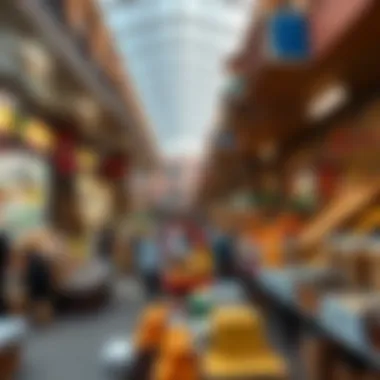

Al Falaj Market isn’t merely a place to shop; it is a microcosm of Dubai itself, where cultures converge and stories unfold, making it an essential stop for anyone interested in the heartbeat of this vibrant city.
Historical Background
Understanding the historical context of Al Falaj Market is crucial for anyone looking to invest or engage with the area. The roots of a market can often influence its present and shape its future. As we delve into the origins and evolution of Al Falaj Market, we will uncover layers of significance that go beyond mere commercial transactions; they reflect cultural interactions, shifts in economic paradigms, and a set of community values that have stood the test of time.
Origins of Al Falaj Market
Al Falaj Market has its origins deeply rooted in the traditional trading practices much like other bazaar-style markets in the region. It sprang to life during a period where trade was essential not just for commerce, but for the very survival of communities. This location served as a pivotal point for traders, supplying essential goods like spices, textiles, and handcrafted items.
Moreover, the market was strategically positioned near key transport routes, making it a popular stopping point for merchants traveling from neighboring regions. As traders set up their stalls, the market became a melting pot of cultures, languages, and ideas.
It's fascinating to note how the name 'Al Falaj' itself suggests a sense of flowing water. In ancient Arabic culture, water was a lifeline, and perhaps this metaphorically indicates how the market provided lifeblood to local commerce. Over the years, by hosting various products from local artisans to regional imports, it not only established its economic footing but also gradually earned a reputation as a community focal point.
Evolution Through the Years
As we trace the journey of Al Falaj Market through the years, it becomes evident how each decade brought shifts that aligned with larger socio-economic changes. From the early days of simple barter exchanges to today’s sophisticated marketplace, the evolution is marked by several key transitional phases.
Initially, Al Falaj Market thrived on a localized economy as folk would trade goods directly. However, with the rise of the petroleum industry in the late 20th century, the influx of wealth and technological advances began to reshape this market. Infrastructure improvements led to better transport links, attracting more visitors and pushing the market to adapt to modern retail trends.
The bricks-and-mortar shops have evolved into a blend of traditional and contemporary stalls, offering everything from traditional Arabic handicrafts to modern electronics.
For investors and stakeholders, the evolution of Al Falaj Market signifies adaptability and resilience. Real estate opportunities blossomed as demand surged, reflecting a growing confidence in the market's potential. The once humble bazaar has morphed into a thriving commercial hub while still maintaining the charm that draws both locals and tourists alike.
"An enduring market does not merely survive; it thrives by adapting to the tides of time and community needs."
This historical backdrop not only enriches the narrative of Al Falaj Market but also sets the stage for understanding its future role in the economic landscape of Dubai.
Cultural Context
Understanding the cultural context of Al Falaj Market is essential, not just for investors but for anyone interested in the intricate fabric of Dubai’s local life. This market serves as a reflection of the city’s unique heritage, combining the traditional Arab marketplace atmosphere with modern consumer needs. The essence of community life and the rhythm of daily interactions shape the market’s character, fostering an environment that attracts both residents and tourists.
Community Life and Interaction
Community interaction is at the heart of Al Falaj Market. Walking through its bustling lanes, one can sense a vibrant tapestry of human connections. Local vendors often recognize their regular customers, resulting in warm exchanges and rapport. This interaction fosters a sense of belonging among community members, where the market becomes a social hub. Families frequent the place not only to shop but also to engage in light-hearted conversations, turning mundane errands into community gatherings.
- Familiar Faces: Regular patrons often enjoy personalized service from merchants who remember their preferences.
- Social Functions: The market provides a venue for people to meet, discuss, and share ideas, bridging generations.
- Cultural Exchange: With its position as a gathering point for diverse cultures, Al Falaj facilitates exchanges that enrich the community’s cultural life.
Such bonds go a long way in reinforcing the market’s appeal, transforming it into a lively tapestry of interactions beyond mere transactions. In essence, the market encapsulates the spirit of the neighborhood, where cultural nuances and community identity coexist in harmony.
Cultural Events and Festivals
The rhythm of life in Al Falaj Market is also punctuated by various cultural events and festivals that celebrate both local traditions and broader cultural dialogues. These events draw in crowds, fostering a strong sense of community and cultural pride.
Important festivals often include:
- Eid Celebrations: Marking the end of Ramadan, these celebrations feature festive decorations, special sales, and community gatherings.
- National Day: A time for showcasing local heritage, with events reflecting Emirati culture, food stalls, and traditional performances.
- Cultural Exchanges: Often organized by local groups, these events promote different cultural heritages through art displays, music, and food, creating a mosaic of diversity.
"Cultural festivals in Al Falaj Market create an immersive atmosphere that not only celebrates traditions but also strengthens community bonds."
These gatherings provide an opportunity for both locals and visitors to come together, enhancing the market's reputation as not only a commercial hub but as a cornerstone of the community’s cultural life. The synergy between daily interactions and celebratory events creates a dynamic atmosphere that is increasingly attractive to investors considering the market’s long-term viability.
Through exploring these cultural dimensions, one can appreciate how Al Falaj Market transcends its role as a business space; it is indeed a lively organism reflecting the essence of Dubai itself.
Economic Significance
The economic landscape of Al Falaj Market illustrates the intricate dance between trade, consumer behavior, and local growth. Understanding the economic role of this market is crucial for investors, realtors, and even homebuyers, as it sheds light on where opportunities may lie. The market is not just a place of exchange; it's a microcosm reflecting larger economic patterns within Dubai.
Commercial Activities within the Market
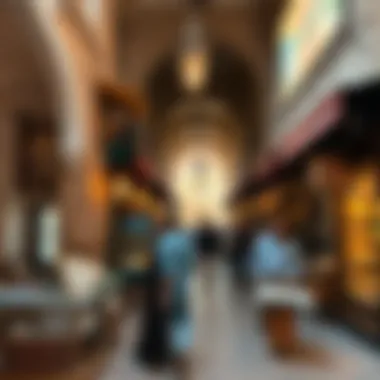

Al Falaj Market is a bustling hub filled with an array of commercial activities. Vendors sell everything from traditional spices and textiles to modern electronics. This diversity not only attracts local residents but also lures tourists looking for authentic experiences. Each stall and shop tells a story, offering products that cater to various tastes and preferences.
- Local Businesses: Many small local businesses thrive here, providing goods that promote local craftsmanship. Artisanal products, handmade textiles, and specialty foods draw customers, supporting the livelihoods of many.
- Retail and Services: Beyond just items for sale, services such as tailoring, mobile repair, and beauty treatments are also available. These services are integral to the community, which relies heavily on the convenience of having everything one needs within walking distance.
- Trade Events: Organized trade events showcase local enterprises. These events not only highlight the market's offerings but also encourage networking among entrepreneurs.
Al Falaj Market stands as a testament to how commerce and community can align, fostering an environment where both can flourish.
Impact on Local Economy
The impact of Al Falaj Market on the local economy is profound and multifaceted. It serves as a vital economic engine within its community.
- Job Creation: The market generates direct employment opportunities in retail, hospitality, and service sectors. This job creation is a boon not just for individuals but for households, ramping up disposable income within the area.
- Tax Revenue: Local businesses contribute to municipal tax revenues, which fund public services such as education, healthcare, and infrastructure. This creates a cycle where the community benefits from its economic activities, leading to overall improvements in living standards.
- Attracting Investment: The market's vibrant commercial activities catch the eye of potential investors. They see the robustness of local demand and the potential for growth, which can encourage further development and investment in surrounding areas.
In summary, the economic significance of Al Falaj Market is not to be underestimated. It is a pivotal player in both supporting local businesses and enhancing community welfare. Those looking to invest should understand that a thriving market environment can lead to prosperous opportunities, making it a vital area of focus in the larger Dubai property scene.
Real Estate Dynamics
Understanding real estate dynamics within Al Falaj Market grants crucial insights into the broader property landscape of Dubai. This sector is not merely about bricks and mortar; it reflects the community's evolving needs and aspirations. Real estate dynamics play a pivotal role in shaping investment strategies, guiding developers, and influencing homebuyers' decisions. Without a solid grasp of these dynamics, stakeholders risk making uninformed choices that could significantly impact their returns.
Factors such as market demand, property prices, and demographic trends shape the real estate scene within Al Falaj. Identifying patterns in these areas can facilitate smarter investments. Consequently, delving into this topic becomes essential for anyone considering entering or expanding their footprint in this market.
Current Trends in Al Falaj Real Estate
The real estate market in Al Falaj has seen a contemporary shift, primarily driven by urbanization and increased migration to the area. One current trend is the rapid development of mixed-use properties. These developments, which seamlessly combine residential and commercial spaces, cater to the desire for convenience among urban dwellers. Buyers are increasingly drawn to properties that offer amenities like shops and recreational areas within walking distance.
Price fluctuations have also caught the attention of potential investors. Analysts note a gradual increase in property prices, spurred on by both local and foreign investment. Another prevailing trend is the rise of eco-friendly buildings. As sustainability becomes more pertinent, Al Falaj is responding with greenery-focused projects that not only lure environmentally-conscious buyers but also yield lower maintenance costs long term.
Listed below are some trends currently shaping the Al Falaj real estate market:
- High Demand for Apartments: An increase in young professionals leads to robust demand for smaller, affordable housing options.
- Focus on Quality Amenities: Properties that provide parks, fitness centers, and communal spaces are gaining favor.
- Greater Digitalization of Transactions: Online platforms for buying and selling properties are becoming commonplace, ensuring convenience.
Investment Opportunities
Al Falaj Market presents a wealth of investment opportunities, appealing to both domestic and international investors. Given its rapid growth and transformation, the area is ripe for those with a keen eye for potential. Prospective investors should consider several factors when evaluating opportunities in this vibrant market.
The ongoing infrastructure projects in the vicinity are noteworthy, as they enhance accessibility and appeal. For example, the expansion of public transport is a significant draw. Properties near these transport links tend to maintain high demand, securing rental income for owners.
Moreover, businesses looking for commercial space can find attractive rental yields in Al Falaj. The market is seeing a surge in retail spaces as more entrepreneurs set up shops to cater to the diverse population.
Potential investors might also want to explore:
- Residential Properties: With increasing interest from expatriates, investing in multi-family housing can yield favorable returns.
- Commercial Ventures: Offices and retail spaces are ideal for those aiming to capitalize on the local entrepreneurial spirit.
- Land Investments: As demand continues to rise, raw land has the potential for significant appreciation when developed properly.
In short, navigating the real estate dynamics of Al Falaj Market presents both challenges and opportunities. By staying informed about trends and leveraging current market conditions, savvy investors can position themselves for success in this continually evolving landscape.
Investing in Al Falaj isn't just about property; it's about understanding the community and evolving dynamics that shape the market.
For further insights on real estate dynamics and opportunities, consider exploring resources on platforms such as Wikipedia, Britannica, or relevant local government sources.
Accessibility and Infrastructure
Understanding accessibility and infrastructure is crucial in the context of Al Falaj Market, especially for potential investors, realtors, and homebuyers. These elements do not just influence visitor flow, but also shape the overall market dynamics, determining how well businesses can thrive and how attractive the area is for future developments.
Transport Links and Connections
When it comes to Al Falaj Market, transport links are the lifeblood that connects it to the rest of Dubai. The market benefits from a well-established network of public transportation options, including buses and metro lines, which makes commuting accessible for both residents and visitors. The nearby Dubai Metro station, for instance, serves as a pivotal hub, facilitating easy travel across the city. Having multiple bus routes that stop near the market enhances convenience as well, drawing in a steady stream of foot traffic.
Within the market area, pedestrian walkways are maintained well, allowing for a comfortable stroll from one end to the other. A few well-placed taxi stands also help to keep transport options varied, promoting a hassle-free experience. For those driving, direct access to major thoroughfares minimizes commutes and makes Al Falaj a prime spot for shoppers and those doing business alike.
Additionally, the expansions underway in Dubai's infrastructure, such as the enhanced road systems, indicate an optimistic view towards the market’s accessibility. As the city grows and evolves, the market finds itself in a position to leverage these developments, further solidifying its role as an economic hub. In summary, when considering a property investment, one cannot overlook the implications of strong transport links and robust connections, which assure customer accessibility.
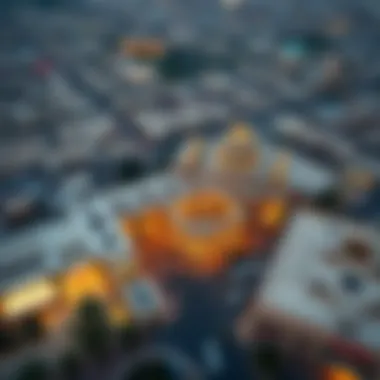

Essential Services and Amenities
In addition to transport links, essential services and amenities in or near, Al Falaj Market play a significant role in its appeal. With an array of services available, from banking facilities to health clinics, both residents and businesses find many needs met locally, reducing reliance on distant locations.
- Banking Services: Multiple banks and ATMs make financial transactions smooth for everyone. Whether it’s withdrawing cash or accessing loans, these facilities contribute significantly to the market's viability.
- Healthcare Access: Clinics and pharmacies in close proximity mean reliable healthcare is only a short distance away. This aspect is particularly attractive for families and vendors seeking peace of mind regarding health services.
- Retail and Dining Options: Various shops and eateries enhance the customer experience, providing everything from daily necessities to unique goods. This diversity not only caters to the market's clientele but also creates an engaging atmosphere fostering repeat visits.
- Community Engagement Spaces: Areas designed for community gatherings or events enhance the social fabric of Al Falaj. Such amenities can support local festivals or cultural happenings, solidifying ties between businesses and residents.
"Investors often overlook the importance of infrastructure as a silent partner in property value; yet, it's the backbone that supports long-term gains."
For further information on transportation systems in Dubai, you can visit Dubai RTA. Also, a look at local services is detailed on Dubai Expo to note how these elements encourage thriving markets.
Challenges Facing Al Falaj Market
The Al Falaj Market, while vibrant and crucial to Dubai's tapestry, is not without its challenges. Understanding these hurdles is key for anyone looking to invest, develop, or simply navigate this bustling hub. From regulatory barriers to intense competition, these factors play a significant role in shaping the future of the market.
Regulatory Barriers
Navigating the rules and regulations in Dubai can sometimes feel like trying to find your way through a maze. Al Falaj Market faces specific regulatory barriers that can hinder smooth operation for businesses and investors alike.
To start with, the licensing process for new ventures can be quite cumbersome. Entrepreneurs often find themselves bogged down by paperwork and delays when trying to secure the necessary permits. Additionally, certain zoning laws might restrict the types of businesses allowed, forcing potential investors to rethink their strategies.
Moreover, changes in government policies also impact market dynamics. When the government implements new regulations, it can create uncertainty, causing hesitation among investors and stakeholders. This unpredictability can stifle growth, making it essential for players in Al Falaj to stay abreast of policy updates.
Market Competition and Saturation
The landscape of Al Falaj Market is bustling with a myriad of businesses vying for the attention of consumers. While friendly competition can spur innovation, it can also cultivate an atmosphere of saturation, particularly in certain sectors. New entrants often struggle to carve out a niche in an already crowded marketplace.
For example, the retail sector has seen a surge in new shops, which makes it increasingly challenging for established businesses to maintain their customer base. Those who do not adapt swiftly to consumer trends risk losing out, resulting in high turnover rates among new businesses. Not to mention, the essence of uniqueness is pivotal. Without offering something distinct, a new shop might just blend into the background noise.
Additionally, the marketing landscape has become increasingly complex. In a place where everyone has a smartphone in hand, standing out requires more than just a good product; it demands a savvy digital presence.
Future Prospects
The future of Al Falaj Market holds significant importance not only for local businesses and residents but also for investors looking for profitable opportunities. Being a vital part of Dubai's diverse economic landscape, the market has the potential to evolve and adapt to the changing market dynamics and consumer preferences. Understanding the projected growth and developments on the horizon gives a valuable canvas for those who have a stake in the real estate and commercial sector.
Projected Growth of the Market
As we look at the future trajectory of Al Falaj Market, several elements come into play that point toward a positive outlook. Trends in demographics and urban development showcase a sharp increase in the number of residents and visitors frequenting the area. The ongoing development of surrounding amenities, coupled with infrastructure enhancements, suggests a healthy market expansion.
- Population Growth: With the increasing influx of residents drawn to Dubai's high standard of living, Al Falaj Market is expected to see a consistent rise in foot traffic. This directly benefits retail businesses as more potential customers arrive.
- Commercial Activity: Local businesses are likely to benefit from improved economic conditions, as traders look to capitalize on increasing consumer spending. More entrepreneurs are exploring opportunities within the market, potentially leading to a diversifying array of shops and services.
- Real Estate Demand: The next few years could witness a significant uptick in the demand for retail spaces and commercial properties in the area. Investors and property developers keeping an eye on Al Falaj Market might find themselves well-positioned to respond to this surge.
"Investing in Al Falaj Market is akin to planting a seed in fertile soil; with the right attention and care, it can blossom into a fruitful venture.”
Developments on the Horizon
Al Falaj Market is not just resting on past success but is poised for several remarkable developments that can reshape its character.
- Revitalization Projects: City planners and local authorities are likely to introduce revitalization measures that aim to enhance the aesthetic appeal and functionality of the market. This might include the refurbishment of existing structures, landscaping, and the addition of modern amenities to create a more inviting shopping environment.
- Technological Integration: As the retail landscape evolves, we might see initiatives to incorporate technology into the shopping experience. For instance, digital payment systems and e-commerce platforms will attract a tech-savvy clientele and enhance customer satisfaction.
- Cultural Initiatives: Planned cultural events can elevate the market's profile as a destination, drawing in both tourists and locals. Integrating cultural festivities and food fairs can further enrich the community experience and foster a collaborative business environment.
In summary, the future of Al Falaj Market is bright with promising growth prospects. Investors and stakeholders should keep a keen eye on both projected developments and market shifts, as this will pave the way for strategic decisions in the coming years.
Culmination
In wrapping up our exploration of Al Falaj Market, it becomes clear that this marketplace is not just a point of commerce but a vital cog in the larger machinery of Dubai’s economic landscape. The intricate history intertwined with the present-day dynamics lends a distinct flavor to what the market represents. It's a bustling hub where tradition meets modernity, offering a wealth of opportunities for various stakeholders—be they investors, homebuyers, or real estate developers.
The significance of a place like Al Falaj Market lies in its role as a bridge bridging the past and present, where every corner has a story to tell, and every stall showcases a blend of local and global flavors. Understanding this market can aid potential investors to not only identify viable opportunities but also grasp the cultural nuances that can significantly impact their long-term strategies.
Moreover, as one dives deeper into the particulars of this vibrant market, it becomes apparent that changes and innovations are continually reshaping its landscape. Keeping abreast of such developments will be crucial for stakeholders looking to capitalize on future growth and trends.
Key Takeaways
- Al Falaj Market is more than a shopping venue; it’s a significant cultural and economic site in Dubai.
- A strong understanding of the historical context can enhance investment decisions within the market.
- Future growth in Al Falaj depends on adapting to changing consumer preferences and regulatory frameworks.
- Investors should remain vigilant regarding infrastructural improvements that can enhance overall market accessibility.
- Engaging with the local community can provide insights that are often missed in formal market analysis.
Final Thoughts on Al Falaj Market
Al Falaj Market stands as a testament to the resilience and adaptability of local commerce, making it ripe for exploration. For real estate professionals, the fusion of cultural heritage with evolving market trends presents a unique case for investment. Those operating in or around Al Falaj must not only harness the obvious economic potential but also appreciate the dynamics of community life that influence consumer behavior. It’s clear that with the right approach, the market offers fertile ground for growth. As we look towards the horizon, the coming years will indeed be pivotal in determining the future path of Al Falaj, ensuring that it remains a key player in Dubai’s ever-expanding tapestry of commerce.
